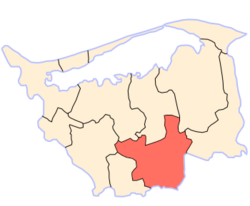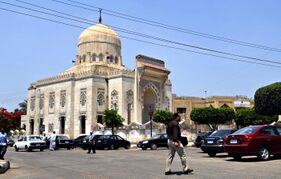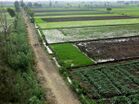Kafr El Sheikh
Topic: Place
 From HandWiki - Reading time: 4 min
From HandWiki - Reading time: 4 min
Kafr El Sheikh كَفرُ الشَّيْخ | |
|---|---|
City | |
 | |
| Coordinates: [ ⚑ ] 31°06′42″N 30°56′45″E / 31.11167°N 30.94583°E | |
| Country | |
| Governorate | Kafr El Sheikh |
| National day | 4th of November |
| Named for | A Sufi Saint |
| Area | |
| • Total | 19.3 km2 (7.5 sq mi) |
| Elevation | 14 m (46 ft) |
| Population (2023) | |
| • Total | ~186,857 (Estimate) |
| • Egypt | 98.042.000 |
| Time zone | UTC+2 (EET) |
| • Summer (DST) | UTC+3 |
| Area code(s) | (+20) 47 |
| Website | http://www.kafrelsheikh.gov.eg |
Kafr El Sheikh (Egyptian Arabic: كَفرُ الشَّيْخ pronounced [kɑfɾ eʃˈʃeːx]) is an Egyptian city and the capital of Kafr El Sheikh Governorate, Egypt, about 134 km north of Cairo, in the Nile Delta of lower Egypt. As of November 2006, the town had a population of around 500,000.[2]
Kafr El Sheikh was earlier known as Duminqun (Arabic: دُمِيْنقُون), but was officially named Fuadiyah or Fouadiyah (Arabic: فُؤادِيَّة) in honour of King Fuad I of Egypt. After the 1952 Revolution and the subsequent abolition of the monarchy, the governorate took the name of its capital city Kafr El Sheikh. This name, adopted in 1955, means "the village of the chief".[3][4][5] In 2006 the University of Kafr El Sheikh was established.
Etymology
The modern name of the city means "village of the sheikh", and refers to sheikh Talhha at-Tilmisānī, who died here in 1234.[6][7]
The older name of the city, Dumaynaqun (Arabic: دُمِيْنقُون), is reconstructed from Coptic by Engsheden as ⲑⲙⲟⲩⲓ ("island") + a personal name. This pattern is widely represented in Egyptian toponymy, so the name is expected to be Egyptian, but he proposes Nikon (Ancient Greek:), which is unattested in Coptic sources, unable to find a suitable Egyptian name.[8] In fact, a personal name Akon (Coptic: ⲁⲕⲱⲛ) is contained in place names like Pmounakon (Coptic: ⲡⲙⲟⲩⲛⲁⲕⲟⲛ, lit. 'the well of Akon') in the Hermopolite nome and Tmounakon (Coptic: ⲧⲙⲟⲩⲛⲁⲕⲱⲛ, lit. 'the island of Akon') near Oxyrhynchus, the latter of which could share its etymology with Dumaynaqun.[9][10]
Geography of Kafr El-sheikh
Kafr El Sheikh is located in the southern side of the Kafr El Sheikh Governorate, it is famous for agriculture, especially the production of rice. The city is surrounded to the east by the villages of Qantara and Sawalha which are separated by a small Canal. Kafr El Sheikh has Desouk and Damanhour to its West, Tanta to its South, and the Mediterranean to its North.
Education

The Governorate of Kafr el Sheikh is the holder of prestigious schools. It also has a university that has the following faculties:
- Faculty of Commerce
- Faculty of Engineering
- Faculty of Agriculture
- Veterinary school
- Faculty of Arts
Main sights
Museum
The city museum showcases artifacts, mostly from Buto. Notable exhibits include artifacts depicting the conflict between Horus and his uncle Set, as well as a remarkable statue of Horus the Falcon. The museum also highlights the period when the city of Sakha hosted the journey of the Holy Family in Egypt. The city of Fuwwah, known for its Islamic heritage, is also featured. The Kafr El Sheikh Museum was inaugurated by President El-Sisi in 2020.
Mosques
- Talha al-Tlemceni
- Abaza
- Al Malek
- Ibn Taimia
- Al Israa
- Ebad al Rahman
- Al Falaheen
- Al Fath (Stadium mosque)
- Al Khayat
- Abo al Azaem
- Sidi Qutb
- Al Rahman (Mosque of el 47 square)
- Sheikha Zahra Coptan
Churches
- Church of the Blessed Virgin Mary in Sakha
- Evangelical Church
- Church of St.Demiana and forty Virgins
- Saint George's Church
Industry
Kafr El Sheikh is the home to various factories, including a rice mill, a poultry forage factory and a sugar beet factory.[11]
Sport
Kafr El Sheikh owns Kafr El Sheikh SC which competes in the Egyptian second division league
Climate
Kafr el-Sheikh is classified by Köppen-Geiger climate classification system as hot desert (BWh).
Script error: No such module "weather box".
Notable people
- Hamdeen Sabahi, Egyptian Politician, the leader of the Dignity Party and one of the leaders of the Egyptian opposition before the 2011 Egyptian revolution
- Trezeguet, Egyptian footballer
- Osama Anwar Okasha, Egyptian screenwriter and journalist
- Saad Zaghloul, Egyptian Nationalist and politician
See also
References
- ↑ "Egypt: Governorates, Major Cities & Towns - Population Statistics, Maps, Charts, Weather and Web Information". https://citypopulation.de/en/egypt/cities/?cityid=595.
- ↑ Central Agency for Public Mobilization and Statistics, Egypten. Accessed 11 November 2006.
- ↑ Room, Adrian (2006). Placenames of the World: Origins and Meanings of the Names for 6,600 Countries, Cities, Territories, Natural Features, and Historic Sites (2nd ed.). Jefferson, NC: McFarland. p. 185. ISBN 978-0-7864-2248-7. https://books.google.com/books?id=M1JIPAN-eJ4C&pg=PA185. Retrieved 2010-08-07.
- ↑ الأسعد بن مماتي. قوانين الدواوين.
- ↑ Carsten Peust (2010). Die Toponyme vorarabischen Ursprungs im modernen Ägypten. pp. 56.
- ↑ الأسعد بن مماتي. قوانين الدواوين.
- ↑ Carsten Peust (2010). Die Toponyme vorarabischen Ursprungs im modernen Ägypten. pp. 56.
- ↑ Engsheden, Âke. Ancient Place-Names in the Governorate of Kafr el-Sheikh. Peeters. pp. 147. ISBN 9789042941755.
- ↑ "TM Places". https://www.trismegistos.org/place/9619.
- ↑ Clackson, S.J.. Coptic documents relating to the monasteries of Apa Apollo at Bawit and Titkooh in the Hermopolite nome. University of London. pp. 68.
- ↑ Kafr Elsheikh Governrate "Kafr Elsheikh Governrate". http://www.kafrtp.gov.eg/kafrinfo.aspx. sic
- ↑ "Climate: Kafr Al-Sheikh - Climate graph, Temperature graph, Climate table". Climate-Data.org. http://en.climate-data.org/location/727/.
[ ⚑ ] 31°06′42″N 30°56′45″E / 31.11167°N 30.94583°E
 |
 KSF
KSF







